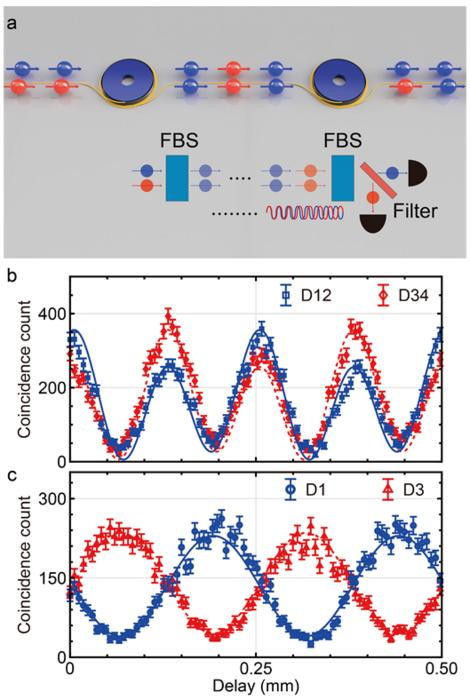In a recent study published in the journal Light: Science & Applications, researchers from Pohang University of Science and Technology (POSTECH) have presented a new type of quantum entanglement where photons are linked by frequency instead of path, achieving double the resolution of traditional methods. This paves the way for more stable and powerful quantum technologies in areas like sensing and communication.

a, an experimental schematics for the frequency-domain entanglement. Two photons with distinct colors, red and blue, are injected into the interferometer constructed with two frequency beam splitters. Then, the resultant interference pattern is measured. b, The measured interference pattern with the two-photon NOON state, showing a two-fold enhancement in resolution compared to the single-photon counterpart. c, The measured interference pattern with the single-photon state. Image Credit: Dongjin Lee, Woncheol Shin, Sebae Park, Junyeop Kim, and Heedeuk Shin
This breakthrough in quantum physics introduces a cutting-edge device called a frequency beam splitter, capable of changing the frequency of individual photons with a success rate of 50 %.
For years, the scientific community has explored spatial-domain photon number-path entanglement, a pivotal element in quantum metrology and information science.
This concept revolves around photons organized in NOON states, where they occupy either one pathway or another. This enables revolutionary applications such as super-resolution imaging, surpassing conventional limits, enhancing quantum sensors, and crafting quantum computing algorithms tailored for tasks demanding remarkable phase sensitivity.
The study, led by Professor Heedeuk Shin from the Department of Physics at Pohang University of Science and Technology in Korea, has introduced entangled states in the frequency domain. This concept resembles spatial-domain NOON states, but with a notable difference: instead of photons being split between two paths, they are distributed across two frequencies.
This breakthrough has enabled the successful generation of a two-photon NOON state within a single-mode fiber, demonstrating the capability to achieve two-photon interference with twice the resolution of its single-photon counterpart. This highlights remarkable stability and significant potential for future applications.
In our research, we transform the concept of interference from occurring between two spatial paths to taking place between two different frequencies. This shift allowed us to channel both color components through a single-mode optical fiber, creating an unprecedented stable interferometer.
Dongjin Lee, Study First Author, Pohang University of Science and Technology
This discovery not only deepens our understanding of the quantum realm but also paves the way for a new era in quantum information processing within the frequency domain. Exploring entanglement in the frequency domain could lead to significant breakthroughs in quantum technology, potentially revolutionizing everything from quantum sensing to secure communication networks.
Journal Reference:
Lee, D., et al. (2024) NOON-state interference in the frequency domain. Light: Science & Applications. doi.org/10.1038/s41377-024-01439-9.
Source: https://english.ciomp.cas.cn/